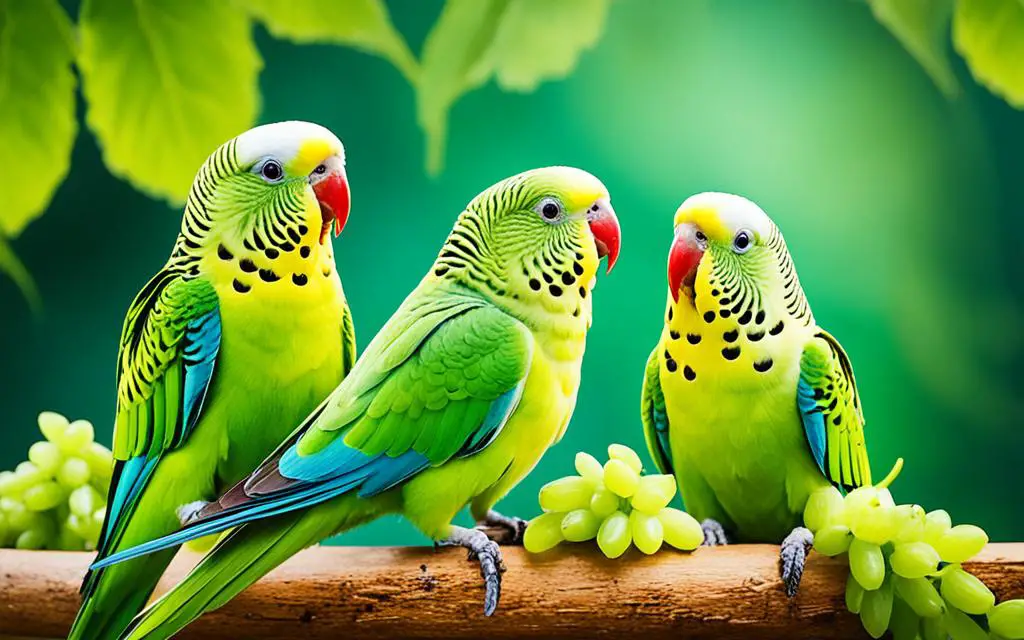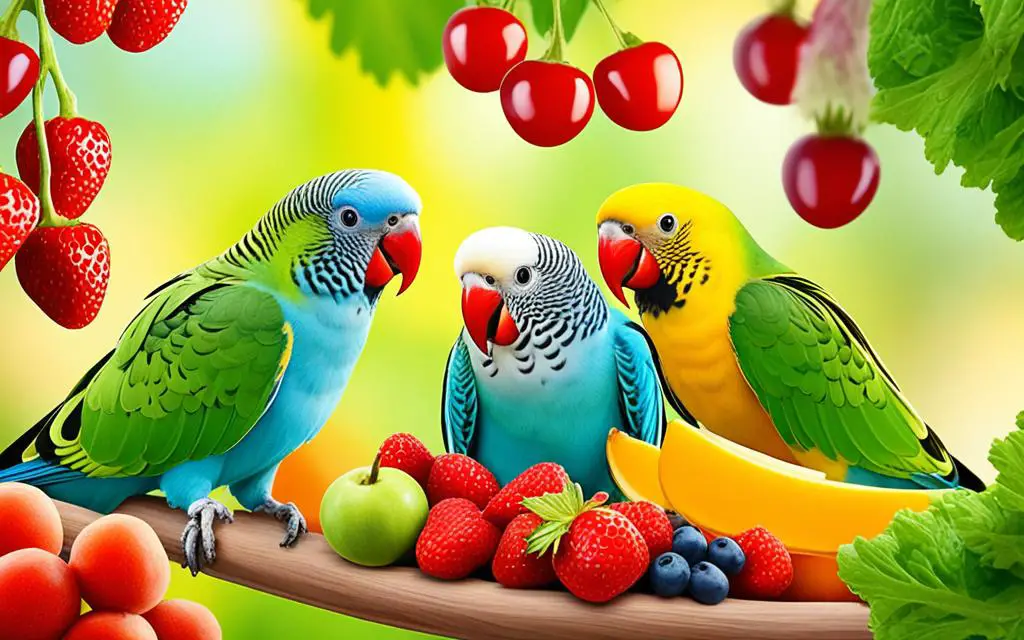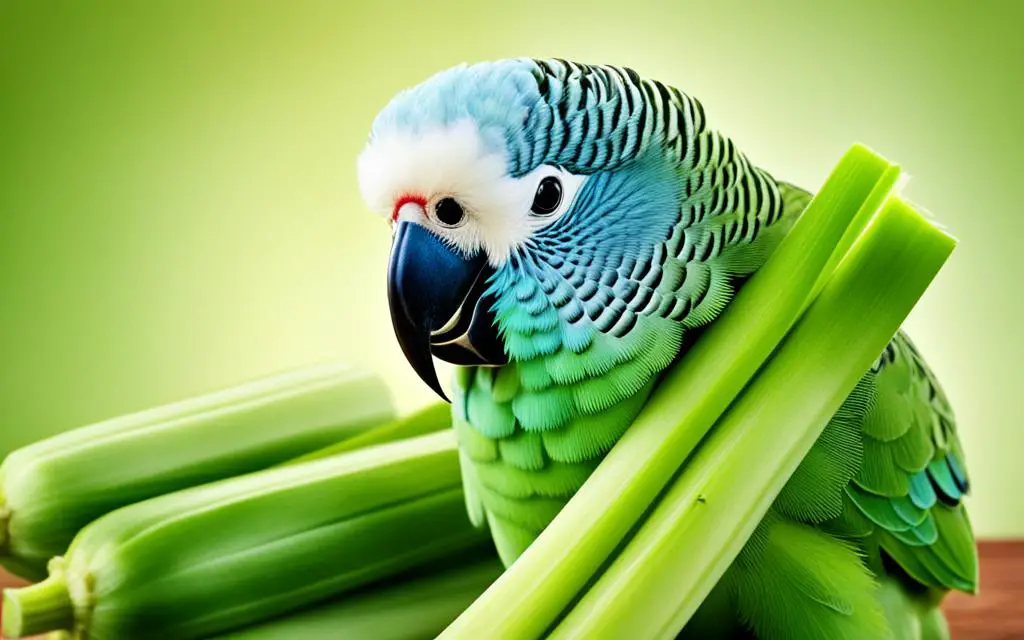When thinking about treats for parakeets, we often wonder, Can parakeets eat celery? It’s surprising to learn that even though seeds and grains make up about 70% of their diet, experts now say fresh foods should be up to 40% of it. For those of us looking for healthy options for our parakeets, celery emerges as an interesting choice. A varied diet, rich in veggies like celery, is crucial for their health.
Can parakeets eat celery? Crunch time: yes, they can!
Yes, feeding parakeets celery is a good idea. It brings new flavors and textures to their food. Since celery is one of the safe vegetables for parakeets, it makes their meals more fun. It helps with their natural urge to search for food. Celery is a healthy treat for parakeets that should be part of their diverse diet.
Overall, a varied diet with fresh foods and pellets can improve your parakeet’s life. This strategy does more than just keep them physically healthy. It also promotes natural behaviors and mental well-being by letting them explore and try new flavors.
Offering a range of foods, including treats like celery, is key to our birds’ well-being. This often-overlooked veggie can be a good addition to their food mix. Let’s dive into why celery is safe for them and how to incorporate it into their meals correctly.
Key Takeaways
- Parakeets can safely eat celery, expanding the variety in their diet.
- Vegetables should represent a sizeable portion of a healthy parakeet diet.
- Thoroughly washed and correctly prepared celery is essential for safe consumption.
- Fresh foods like celery provide hydration and essential nutrients to parakeets.
- Establishing a balance between seeds, fresh produce, and parakeet treats is crucial for their health.
- Consulting with avian vets can guide owners in making the best dietary choices for their pets.
Understanding Parakeets’ Diet and Nutrition Needs
When thinking about what parakeets eat, knowing the basics of a healthy diet matters a lot. Giving them the right foods helps keep them healthy and may even make them live longer. Let’s talk about why a balanced diet, including vegetables, is key and how to introduce new foods to them.
Essentials of a Balanced Parakeet Diet
A balanced diet is crucial for a parakeet’s health. While they used to eat mostly seeds, now it’s important to give them different foods for all the nutrients they need. Experts often recommend high-quality pellets as a main food because they have lots of necessary nutrients and help manage how much a parakeet eats each day.
The Role of Vegetables in Parakeet Nutrition
Vegetables are a must in a parakeet’s daily diet, not just an extra. They gain a lot from the vitamins, minerals, and fiber in various vegetables. From crunchy carrots to sweet corn, each veggie adds new tastes and textures, making life better for your parakeet.
Transitioning from Seeds to a Diverse Diet
Shifting from a seed-only diet to one with more variety can take time. Be patient and introduce new foods bit by bit. Try mixing things they already like, such as apple slices or romaine leaves, with new snacks. This helps your parakeet get used to a broader diet more easily, taking in essential nutrition tips along the way.
| Vegetable | Benefits | Feeding Tips |
|---|---|---|
| Celery | Low in calories, provides dietary fiber and enrichment due to its crunchy texture. | Offer in moderation as part of a balanced diet. Remove strings to prevent choking. |
| Carrots | Rich in beta-carotene and vitamins for eye health. | Wash thoroughly and serve in small chunks or shredded. |
| Spinach | High in vitamins A, C, and K, as well as iron, crucial for overall health. | Provide in moderation to avoid calcium binding effects. |
| Peas | Contain vitamins and minerals, plus a good source of protein. | Can be served raw or boiled, making sure they are cool before offering. |
Celery is a crunchy food for parakeets, but it’s important to not overdo it. Even though it’s safe, it should only be a small part of what they eat. Giving a variety ensures your parakeet stays healthy and happy.
Nutritional Benefits of Feeding Celery to Parakeets
Parakeet owners looking to improve their pet’s diet should consider celery. It has important vitamins and minerals. It promotes great parakeet nutrition and gives a crunch they adore. We’ll explore the nutrients and pleasures celery brings to our bird friends.
Vitamins and Minerals in Celery
Celery is a top pick among vegetables for parakeets. It has vitamin A, vital for eyesight and immune health. Vitamin C helps repair tissues, and vitamin K is key for blood and bones. Celery also offers folate for cell function and potassium for fluids and nerves. This shows celery’s unique role in a parakeet’s diet.
The Crunch Factor: Why Parakeets Enjoy Celery
Celery’s crunch is irresistible to parakeets. This texture excites them and promotes foraging. The chewing also aids beak health, making celery a great snack.

Hydration and Celery: Additional Hydration for Your Feathered Friend
In hot or dry places, parakeets need extra water sources. Celery’s high water content is perfect for this. Adding it to their diet boosts moisture levels, complementing their water dish.
| Nutrient | Benefits to Parakeets | Amount in Celery |
|---|---|---|
| Vitamin A | Improves vision and immune system health | 22 IU per stalk |
| Vitamin C | Facilitates tissue repair and enzymatic functions | 0.7 mg per stalk |
| Vitamin K | Essential for blood coagulation and bone metabolism | 11.1 micrograms per stalk |
| Folate (B9) | Supports cell growth and DNA synthesis | 10 micrograms per stalk |
| Potassium | Maintains proper fluid balance and nerve function | 104 mg per stalk |
Giving your parakeet celery along with other nutritious foods boosts their health and life span.
How to Safely Introduce Celery into Your Parakeet’s Diet
Introducing new foods to your parakeet, like celery, requires mindful preparation to ensure the utmost safety and nutrition for your feathered friend. Here’s how to prepare celery for parakeets delicately and the vital aspects to keep in mind.
Washing and Preparing Celery for Safe Consumption
Preparing food for your parakeet starts with thorough washing. This removes harmful pesticides or contaminants. Rinse the celery under cold, running water and scrub with a vegetable brush.
After cleaning, cut the celery into small pieces. This prevents choking and makes it easy for parakeets to eat.
Portion Sizes: How Much Celery Can Parakeets Eat?
When deciding how much celery your parakeets can have, remember, less is usually better. Celery is high in water and low in nutrients compared to other veggies. Give a few small pieces once or twice a week for them to enjoy safely.
Avoiding the Celery Leaves: Understanding Potential Risks
Wondering if parakeets can eat celery leaves? It’s best to avoid them.
Some say celery leaves might have more toxins, like the risks with too much celery. Stick to giving your bird the stalk for safety.
| Celery Part | Recommended? | Notes |
|---|---|---|
| Stalk | Yes | Wash thoroughly and cut into small pieces |
| Leaves | No | Potential for higher toxin levels, best to avoid |
| Seeds | No | Not commonly found in regular celery, but should be avoided if present due to potential toxicity |
By following these steps, you can introduce celery into your parakeet’s diet safely. It gives them a fun, crunchy treat. Always watch your bird for any bad reactions to new foods. If you’re unsure about changes to their diet, talk to an avian vet.
Other Vegetables and Treats Parakeets Can Enjoy

Exploring the best vegetables for parakeets adds excitement to their meals. It boosts their health with vital nutrients. Vegetables like broccoli and carrots bring vitamins and variety to their diets. Can parakeets eat broccoli? Yes, they can. It’s a great choice that gives vitamin C and K. Just wash and chop it well to make mealtime fun and good for them.
Root veggies like carrots are also loved by these birds. And yes, can parakeets eat carrots? They sure can. Carrots offer beta-carotene, which is good for them, and make their food more interesting. Remember to serve them in small, thin slices or shredded.
Spinach and kale should not be forgotten. They are full of iron and calcium. This means the answer to can parakeets eat spinach and kale is definitely yes. Make sure they are fresh and clean to avoid chemicals. It’s best to give them in small, finely chopped pieces.
Fruits are also on the menu. Can parakeets eat apples? Yes, they can enjoy apples without the seeds, which are harmful. Apples are rich in fiber and vitamins. They give a sweet change from green veggies.
In conclusion, mixing these fruits and vegetables makes your parakeet healthy and lively. Choose fresh, organic options and prepare them well. Introduce new foods slowly and watch how your bird reacts. This ensures they happily adjust to their better diet.
Conclusion
Caring for parakeets means giving them the right food. Their diet needs to be special to keep them healthy. Giving them a variety of nutritious foods helps them thrive. Celery is one of those good foods. It’s safe for birds to eat celery if it’s prepared right.
For those who love parakeets, we must be careful with their diet. Food must be fresh, clean, and well-balanced. Celery adds fun and important nutrients to their meals. Always make sure they have clean water. And talk to bird vets to keep up with the best foods for your bird.
Adoring parakeets means feeding them well. Include many veggies, fruits, and special pellets in their diet. This care keeps them healthy and happy. Let’s make sure our parakeets’ diets reflect our love for them. This way, they’ll continue to brighten our lives with their presence.
FAQ
Can parakeets eat celery?
What are the essentials of a balanced parakeet diet?
What role do vegetables play in parakeet nutrition?
How can I transition my parakeet from seeds to a diverse diet?
What are the nutritional benefits of feeding celery to parakeets?
Why do parakeets enjoy celery?
Does celery offer hydration to parakeets?
How should I wash and prepare celery for my parakeet?
How much celery can parakeets eat?
Is it safe for parakeets to have celery leaves?
Besides celery, what other vegetables and treats can my parakeet enjoy?

My name is Shane Warren, the author behind Your Bird Buddy – your ultimate guide to the wonderful world of birds! Unleash your inner avian explorer as we delve into a vibrant library of knowledge dedicated to all things feathered. From learning about diverse bird species from across the globe to understanding their captivating habitats and behaviors, I’m here to fuel your passion for these magnificent creatures. Not only that, but I also provide valuable insights on being a responsible and informed pet bird owner. Join our vibrant community and let’s celebrate the feathered wonders of the world together – one chirp at a time. And be sure to join our Your Bird Buddy Community over on Facebook!


Comments are closed